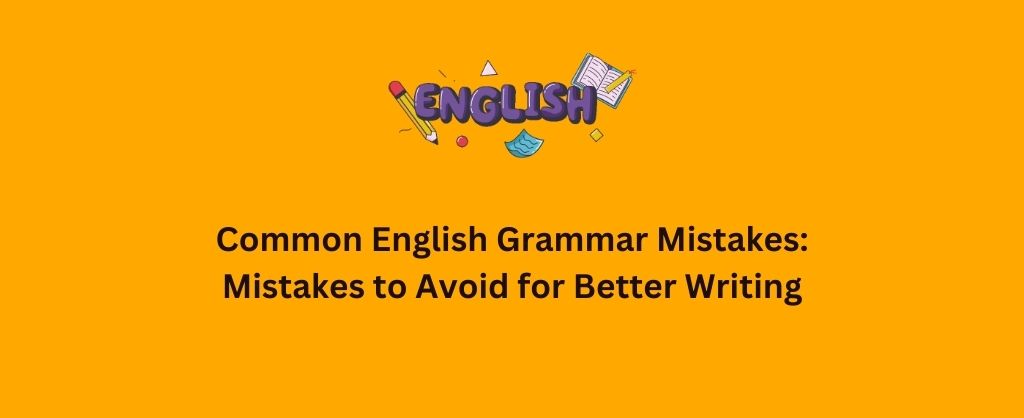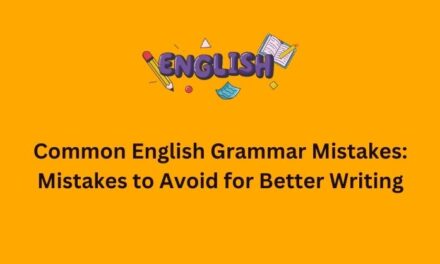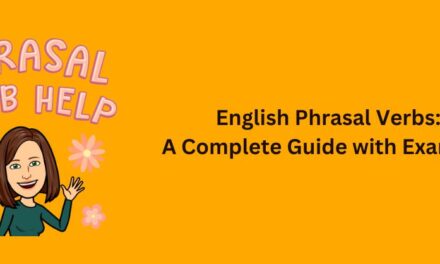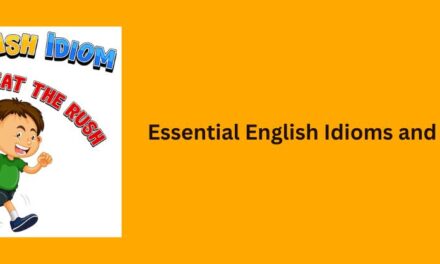Improve Your English Grammar: Fix the Top 14 Grammar Mistakes

Let’s face it – English grammar can be tricky! Even native speakers mess up grammar rules all the time. But having good grammar is important for speaking and writing both.
Most common English grammar mistakes and tips for avoiding them
This guide will cover the most common grammar mix-ups and simple tips to fix them. I’ll explain each mistake with easy examples so you can see what the problem is. You can also watch the videos to understand and learn in details.
1. Using the Wrong Tense
One of the biggest grammar challenges is getting your verb tenses right. I’m sure you’ve wondered before – do I say “I go” or “I went”? Using the wrong tense can sound weird or change the meaning completely.
- Incorrect: Yesterday I go to the store.
- Correct: Yesterday I went to the store.
- Incorrect: I’m take a vacation next week.
- Correct: I’m taking a vacation next week.
- Incorrect: By next year, I work here for 5 years.
- Correct: By next year, I will have worked here for 5 years.
Here are some tips to keep your tenses straight:
- For things that happened in the past, use the past simple tense. For example, “I went to the park yesterday.”
- When you want to talk about the future, use “will” plus the base verb. Like, “I will go to work tomorrow.”
- Use the present continuous tense for things happening right now. For example, “I am reading this article at the moment.”
See the difference? Getting the tense right helps match the timing you want to express.
2. Mixing Up Singular and Plural
Another common slip-up is using the wrong noun form – singular or plural. For instance, people might say “She have a car” instead of “She has a car”. Or “The dogs bark loudly” rather than “The dog barks loudly.”
More examples:
- Incorrect: The student have arrived.
- Correct: The students have arrived.
- Incorrect: The company value good customer service.
- Correct: The company values good customer service.
It’s easy to get tripped up on singular versus plural:
- Use singular nouns when referring to one person, place, or thing. For example, teacher, country, desk.
- Make nouns plural by adding -s or -es when there’s more than one. For instance, teachers, countries, desks.
- Some plural nouns are irregular, like men, mice, and children.
- Double check that your verbs, adjectives, and pronouns match the singular or plural noun.
See – those little -s endings make a big difference!
Essential English Idioms and Phrases And How to Use Them
3. Misusing Confusing Words
Even advanced speakers mix up words that sound alike or have similar meanings.
For instance, they might write:
- “I loose my keys all the time” (supposed to be lose)
- “Your picking the kids up today” (supposed to be you’re)
- “Lets eat out tonight” (supposed to be let’s)
It’s confusing, I know! To avoid these errors:
- Learn the differences between often mixed up words like lose/loose, they’re/their/there, and your/you’re.
- Double check words you’re unsure about in a dictionary.
- Read your writing carefully to catch wrong word usage.
4. Run-on Sentences and Fragments
Run-on sentences and fragments are issues with sentence structure.
Run-ons join two or more sentences incorrectly, for example:
- “I went to the park I played football.” (Should be two separate sentences)
- Incorrect: I went to the store I bought some milk.
- Correct: I went to the store. I bought some milk.
- Correct: I went to the store and bought some milk.
Fragments are incomplete sentences, for example:
- “After I made dinner.” (Needs a complete thought attached)
- Correct: After I made dinner, I went for a walk.
Here are some tips to build sentences properly:
- Read your writing out loud – you’ll hear when a run-on needs to be broken up or a fragment needs more info.
- Use conjunctions like “and”, “but”, or “because” to connect clauses.
- Make sure each sentence has a subject and verb to express a complete thought.
5. Misplaced Modifiers
Modifiers are words that describe other words. It’s important to place them next to the word they modify. If not, it can change the meaning of a sentence.
- “Jenny quickly ran upstairs with red shoes.” (Sounds like the shoes are quick, not Jenny!)
- Correct: Jenny ran upstairs quickly with red shoes.
- “We bought the stale bread on sale.” (Makes it sound like the sale is stale, not the bread)
- Correct: We bought the stale bread that was on sale.
Tips to place modifiers correctly:
- Put descriptive words and phrases right next to the person, place or thing they are describing.
- Read back your sentences to double check the meaning is clear.
- Move misplaced modifiers to their proper place.
6. Common Article Errors
Articles are short words like “a”, “an” and “the” that go before nouns. They may seem insignificant but mistakes with articles can change the meaning.
For example:
- “I ate apple this morning” (should be “an apple”)
- “It was good book” (should be “a book”)
Tips to use articles properly:
- Use “a/an” before a singular countable noun when mentioning it the first time.
- Use “the” before a noun when referring to a specific person, place, or thing.
7. Subject-Verb Agreement Issues
This one’s a little more complex but so important! Subjects and verbs must match in number – singular with singular, plural with plural. If they disagree, your sentence will be wrong.
For example:
- “Amy walk to the park every evening.” (Amy is singular but walk is plural verb)
- Correct: Amy walks to the park every evening.
- “The dogs barks loudly.” (Dogs is plural but barks is singular)
- Correct: The dog barks loudly.
To keep subjects and verbs in harmony:
- Identify the subject and make sure the verb matches in singular or plural form.
- For compound subjects joined by “and”, always use a plural verb.
- Some collective nouns can take a singular or plural verb, like team or staff. The verb depends on the meaning.
8. Pronoun Errors
It’s all too easy to use pronouns like “it”, “they”, “her” incorrectly.
For example:
- “Susan bought groceries after Tom went to the store because he was hungry.” (Unclear who “he” is referring to)
- “The teacher said they would think about it.” (They is plural but teacher is singular)
- Correct: The teacher said she would think about it.
Tips to use pronouns correctly:
- Make sure each pronoun clearly refers to its intended noun. Add context if needed.
- Avoid using ambiguous pronouns like they/them or this/that without a clear noun reference.
- Use singular pronouns (he, she, it) for singular nouns and plural pronouns (they, them) for plural nouns.
9. Capitalization
Proper capitalization may seem like a small detail, but it’s important for names, titles, headlines, and lots more.
Here are some capitalization slip-ups to avoid:
- Forgetting to capitalize the first word of a sentence
- Capitalizing common nouns like teacher or country
- Not capitalizing proper nouns like tim and texas
Keep these capitalization fundamentals in mind as you write:
- Capitalize the first word of a sentence, names, and proper nouns.
- Days of the week and months are capitalized but seasons aren’t.
- Don’t overdo it! Capitalize titles and headings only when grammatically correct.
- The personal pronoun “I” must always be capitalized, regardless of where it appears in a sentence.
10. Mastering Commas
Commas can be confusing. We often throw them in writing when they’re not actually needed. Two common comma errors are:
Comma splices: Joining two sentences just with a comma, like –
“It was raining, I took an umbrella.”
Fused sentences: No comma where you need one, like –
“It was raining I took an umbrella.”
Correct: It was raining, so I took an umbrella.
Here are some tips for proper comma usage:
- Separate independent clauses into two sentences or use a conjunction.
- Read your writing aloud and see if you would naturally pause where commas are placed.
- Don’t go comma crazy! They should only be used if grammar rules require them.
11. Dangling modifiers
Dangling modifiers are confusing because they unintentionally describe the wrong thing.
For example:
- “Riding my bike quickly, the tree branch hit me.” (Incorrectly says the tree branch was riding the bike!)
The fix is easy – just move the modifier to the right place:
“Riding my bike quickly, I was hit by the tree branch.”
In general, place any introductory phrase near the noun it modifies to avoid dangling. And read carefully to double check!
12. Parallelism
This one’s a little fancy – it just means keeping consistent grammar patterns when listing things.
For example:
- “Mary likes hiking, swimming, and reading books.” (All activities use “-ing” verb forms – this is parallel.)
- “We need to buy groceries, paying bills, and go to the bank.” (Not parallel structure – the activities don’t match.)
- Correct: We need to buy groceries, pay bills, and go to the bank.
To use parallelism effectively:
- Use the same grammatical structure for each item in a list – nouns with nouns, verbs with verbs, etc.
- Repeat any articles (“a”, “the”) or prepositions (“on”, “with”, etc) that start each element.
- Rearrange lists that aren’t parallel yet. This takes practice!
13. Apostrophe
Many grammar guides could be summed up as “beware the apostrophe!” This sneaky punctuation mark causes a lot of trouble. Apostrophes have two main jobs:
- Showing possession – “Sara’s laptop” (The laptop belongs to Sara.)
- Contractions – “Let’s go to the cafe.” (Let’s is a contraction of “Let us”.)
- Incorrect: Its been a long day. (Its = belonging to it, It’s = it is/it has)
- Correct: It’s been a long day.
- Correct: Its mine.
- This is teacher’s rooms. (The room is for only one teacher.)
- This is teachers’ room. (The room is for all the teacher.)
Just remember:
- Use apostrophes for possession and contractions only!
- For singular possession, add ‘s (teacher’s). For plurals ending in s, just add ‘ (teachers’).
- Contractions join two words together, like “do not” becoming “don’t.”
14. Lack of Conjunctions
Sometimes writing flows better when you connect shorter sentences together. For example:
- “I went to the store. I bought milk. Then I went home.”
- Better: I went to the store and bought some milk. Then I went home.
- Or, I went to the store, where I bought some milk. Then I went home.
Tips to use conjunctions effectively:
- Use conjunctions like “and”, “but”, and “because” to combine short and related sentences.
- Use punctuation like semicolons and dashes to join loosely connected sentences.
- Vary sentence length for better flow. Too many short sentences can sound choppy.
Phew, we covered a ton of ground on common grammar trouble spots! Here are the key takeaways:
- Get your tenses, singular versus plural, articles, and other grammar basics down cold.
- Master punctuation like commas, apostrophes, and sentence separation.
- Read your writing carefully and fix errors one by one.
- Use spellcheck and dictionaries to support you.
- Keep practicing – grammar skills take time to refine.
I hope these tips give you the knowledge and confidence to catch the most common grammar mistakes in English. Just remember – even native speakers have to check themselves. So you’re not alone! With consistent practice, you’ll be writing with proper grammar in no time.









